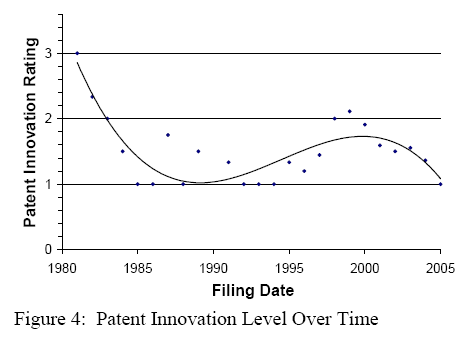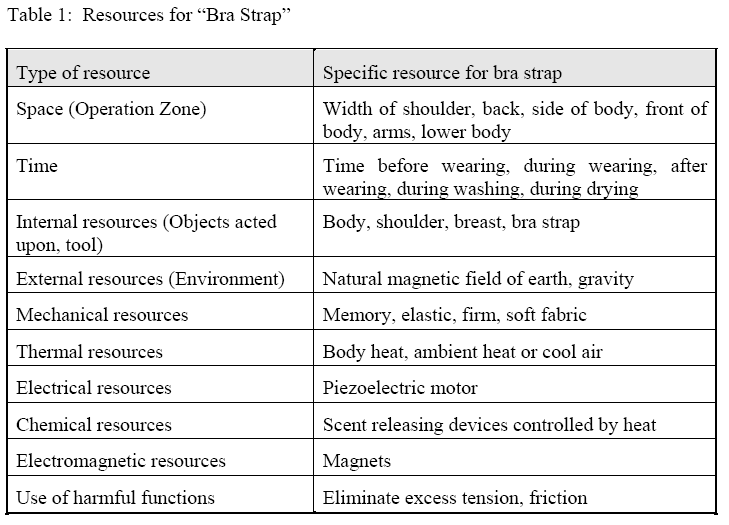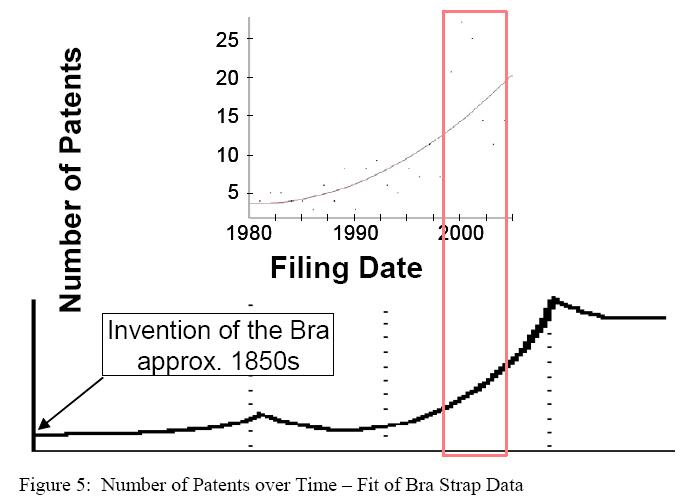The Application of TRIZ to Technology Forecasting - A Case Study: Brassiere Strap Technology
Editor | On 10, Jan 2006
By: Kim Lovel, Chad Seastrunk, Timothy Clapp, Ina Parker
Abstract
Companies must continually develop new products or improve upon existing ideas in order to keep up with competitive markets. One tool to stimulate creative product development is TRIZ (Theory of Inventive Problem Solving). This paper describes a case study applying TRIZ to forecast the technology development of the bra strap. The TRIZ methodology is used to determine the existing state of the technology and its future potential. It is shown how TRIZ can be used to stimulate new product ideas.
Technology Forecasting – Why TRIZ?
In today’s competitive market, manufacturing companies are looking for an edge on their competitors. One area in which this edge can be gained is the development of innovative new products. There is a multitude of traditional, established forecasting tools, such as intuitive or judgmental models, curve fitting and extrapolation of trends, or statistical time series models, used to aid a company’s research and development department in making strategic decisions for product development [1, 2] . Generally, these forecasting methods are based on the choice and analysis of individual, specific parameters as descriptors of the technology. As a result, the concluded forecasts may be subjective and may not reflect all aspects of the technology.
A different, complementary approach to technology forecasting is provided by tools of the Theory of Inventive Problem Solving, known by the Russian acronym TRIZ. The TRIZ approach is structured and systematic, assuring a close-to-objective analysis of the entire technological system from the past to the future. In addition, the TRIZ forecasting methodology seamlessly expands to produce innovative ideas for new product development based on the status of the product technology in the market [3] .
TRIZ Background
In the 1940’s, Russian Inventor Genrich Altshuller developed a theory to describe how inventions are generated, based on the extensive analysis of thousands of patents. His research led to the creation of the theoretical superstructure TRIZ. TRIZ is a system of many powerful tools for problems analysis, understanding and solution, which can be applied to accelerate product development resulting in a patented solution [4] . Several TRIZ tools focus on problem solving during product development, such as the 40 Principles to solve contradictions, the concept of Ideality, or the Substance-Field Analysis. In addition, TRIZ offers tools to determine the status and the future of a specific product technology. Some of the tools used are:
• Analysis of the technological system in the past, present and future
• Analysis of the technological system at different detail levels
• Determination of trends of evolution
• Maturity mapping [3, 4]
The purpose of this paper is to show how TRIZ can forecast and innovate the product development process using the bra strap as a case study. The systematic approach in this study shows that the TRIZ method of technology forecasting can seamlessly lead into new, innovative product ideas. These ideas can accelerate a company’s product development process as a whole.
History of the Bra
The term brassiere was first utilized by Vogue Magazine in 1907, but first records of bralike garments date back to 2500 BC. The first known patents for these devices were filed in the 1850’s. In 1893, Marie Tucek designed the first brassiere that resembled the modern day brassiere [5] . The design consisted of a separate pocket for each breast, hook-and-eye closures, and shoulder straps. Since then, the components of the bra have evolved according to required functions and changing fashion. Some of the many functions include minimizing, enhancing, supporting, and increasing comfort. TRIZ Patterns of Evolution of Technological Systems
In his analysis of patents in many different technologies, Altshuller recognized eight patterns in how systems develop over time [4, 6, 7] :
1. Evolution in Stages (Technical system follows the biological s-curve)
2. Evolution Towards Increased Ideality
3. Non-uniform Development of System Elements (Subsystems evolve at different rates)
4. Evolution Toward Increased Dynamism and Controllability
5. Increased Complexity then Simplification (Reduction)
6. Evolution with Matching and Mismatching Components
7. Evolution Toward Micro-level and Increased Use of Fields
8. Evolution Toward Decreased Human Involvement
These eight patterns can be exploited individually to analyze where a technology is coming from, and to generate ideas about where the technology will evolve in the future. In the following sections of this paper, several tools relating to the individual patterns of evolution will be used to determine the state of bra strap technology, and develop new product ideas.
Evolution in Stages – TRIZ Maturity Mapping
Biological and technological systems go through different steps of evolution. Altshuller used his research to categorize evolution into four stages: infancy, growth, maturity, and decline. The utilization of this theory allows companies to not only see the current state of the technology, but also to be able to predict its future fate and potential. Figure 1 shows the “Biological S-Curve†developed by Altshuller [4] .

In order to determine at which stage of the Biological S-Curve a current technology is located, Altshuller developed four descriptive curves, as shown in Figure 2: A) Number of inventions or patents over time, B) Level of inventiveness over time, C) Performance over time, and D) Profitability over time.
The dotted vertical lines in the graphs of Figure 2 divide each of the curves into the four stages of the Biological S-Curve.

Maturity Mapping of the Bra Strap
A patent search covering the time period from 1976 to the present was conducted, relating to the bra strap. Combinations of several descriptors, such as bra, strap, strapless, brassiere, lingerie, underwear, were used, in order to assure a complete and concise patent data base. The search (bra and strap) produced 336 patents. The search was narrowed using (bra and strap andnot strapless). The titles and abstracts of the 291 results for this search were evaluated. Of these 291 patents, about 150 patents were identified that truly contained a novelty relating to the strap of the bra. Upon closer examination, some of these patents were traced back to their reference patents, which also contained inventions concerning the bra strap. The resulting patent collection of 172 patents is attached as Appendix A. Some patents include inventions relating to sections of the bra other than the bra strap. However, the comprehensive patent search as described above assured that every patent containing an invention relating to the strap of the bra was included in the patent database.

In Figure 3, the number of patents is plotted over a time axis. While the individual points depict the data found for each individual year, the continuous graph shows the best fit of an averaged curve.
In order to generate the descriptive graph for “Level of Inventivenessâ€, the patents were assessed quantitatively based on Altshuller’s “5 Levels of Inventivenessâ€. Each patent was analyzed in terms of five different criteria:
A) Field of invention vs. field of problem
B) Solution mechanism
C) Characteristics of the system
D) Effects or principles leading to the invention
E) Existence of contradictions
Each criterion is categorized at a level between one and five, five being the most inventive. The final rating of inventiveness or innovation rating as plotted in Figure 4 is calculated as the average of the rating in each category. A concise table depicting the rating criteria is attached as Appendix 2.
The individual points in Figure 4 show the average ratings of all patents filed in each single year. The continuous graph depicts the best fit of an averaged curve of the innovation level of all patents as analyzed.

Data for the performance or profitability of the bra strap were unavailable, since these parameters are either kept confidential by the manufacturers, or they are accessible only at a high price from commercial market research companies.
The next step towards maturity mapping of the bra strap technology was to compare the graphs for Number of Patents and Patent Inventiveness over Time with the corresponding descriptive curves developed by Altshuller.
The bra, complete with an early type of strap, was first invented and patented in the 1850s. This corresponds to the beginning of Altshuller’s curve at the infancy stage. The rising number of patents in the bra strap technology in recent years can be fit to Altshuller’s descriptive, qualitative curve for Number of Patents over Time in the maturity phase, as indicated with a red box in Figure 5.

This conclusion is confirmed by the fit of the curve for Patent Innovation Level, depicted in Figure 6. A decline in patent inventiveness from the 1980s to the present matches the growth and maturity phase. The slight bump in innovation level of the bra strap during the maturity phase can be interpreted as the addition of innovative features to the strap as an attempt to rejuvenate the technology. According to Figure 6, the bra strap technology has reached the maturity phase in the present, as indicated with a red box. Analysis of both, Number of Patents and Patent Innovation Level, indicates that the current stage of bra strap technology has reached maturity, as shown in Figure 7.

Since the Bra Strap technology is identified to be in the maturity stage of its biological scurve, its corresponding curves for performance and profitability as shown in Figure 2 are nearing their decline. In order to keep up performance, consumer satisfaction and business profitability, it is essential to rejuvenate the bra strap technology with innovative product development.
The Bra Strap – Ideal Final Result
As stated in the TRIZ 8 Rules of Evolution, every technological system evolves toward a final “Ideal†system. The formulation of the Ideal Final Result helps to focus on the true problem and helps to identify the technical and physical contradiction. There are several different levels and ways to formulate the Ideal Final Result. In the case of the bra strap, two possible formulations are:
“The bra supports itself (no strap needed)†or “The bra strap supports the bra and the breast and adds comfort and fashion.†While the first formulation of the Ideal Final Result is a closer approach to an ideal solution for the supersystem bra, the second statement is more helpful for the innovative construction of a bra strap. It states that the bra strap has no harmful effects such as hurting the body or being a fashion flaw; in the opposite, it adds comfort and fashion. This statement for the Ideal Final Result suggests finding actions, substances or fields that can create comfort and fashion in a bra strap in addition to, not in contradiction to, its primary function of giving support.
Analyzing the Ideal Final Result pinpoints contradictions of the system as it currently exists. Why is the current system NOT ideal? In the case of the bra strap, examples for contradictions are:
1. A strap that gives good support digs into the skin and thus causes discomfort.
2. A wide strap that gives good support and does not dig into the skin compromises fashion.
3. An elastic strap that adjusts the tension needed to give just the right amount of support to be comfortable and to not dig into the skin needs a buckle or fastener for the adjustment, which is a fashion flaw. These contradictions can be formulated by TRIZ in a more abstract way as physical or technical contradictions.
The technical contradiction in situation 1 is that the strap needs to be strong for support, but its strength compromises comfort, as it is putting pressure onto the shoulder. The abstract contradiction is when strength increases (good), pressure increases (harmful effect).
In situation 2 of the example, the contradiction is even simpler. The physical contradiction is that the strap should be wide for comfort and support but narrow for fashion reasons.
In the 3rd situation, the contradiction could be isolated as: the bra strap should be firm for maximum support but should be elastic for maximum comfort. Development of the Bra Strap – TRIZ Systems Approach
Another pattern of evolution identified in the TRIZ technology is the non-uniform development of subsystems or parts. In order to accelerate innovation, subsystems that hinder product innovation must be identified and addressed. The technology system containing the bra strap was analyzed using the TRIZ Systems Approach. The technology is visualized in a three-by-three matrix with different time levels in the horizontal direction, and different detail levels in the vertical direction. The three time levels analyzed are past, present and future, while the three different detail levels are labeled as Supersystem, System, and Subsystem [9] .
The first system approach matrix was created with the idea of the bra as the system, as shown in Figure 8. This matrix helped to realize that the system “bra†contains far too many components and is too complex to serve as basis for new development. Therefore, a complementing matrix at a more detailed level was created using the “bra†as the Supersystem and the“bra strap†as the System, as shown in Figure 9.

The Systems Matrix visualizes from two directions to where the bra strap technology might develop in the future. It is of practical help to the development engineer because it forces questions like:
• Which are the subsystems holding back new development and what are their shortcomings?
• What were parts and characteristics of the bra strap in the past, what are the current parts and characteristics and what are possible parts and desirable characteristic relevant for the future?
• What are desirable characteristics of the bra as a whole (and supersystem), how could the bra strap contribute to achieve these and what parts and characteristics at a more detailed level are necessary to achieve these? A few ideas for a future component of the bra strap displayed in Figure 9 have already been patented, but are not yet commercially developed.
Analysis of the Bra Strap at a Micro-Level
The 7th trend of evolution in TRIZ is the development towards micro-level. Analyzing the system at a microlevel is helpful to address contradictions identified in the system “bra strapâ€. The corresponding TRIZ tool is “Many Little People†modeling, which visualizes the problem in microscopic detail.
In Figure 10, “Many Little People†are performing various functions to counteract the contradictions of the bra strap.

The Bra Strap – Analysis of Resources
Hand in hand with the evolution towards micro-level elements, technological systems evolve towards the use of fields. Fields are energy resources available in the system. In addition to energy fields, other kinds of resources that are not recognized at first sight, may be available in the system. A systematic analysis of all resources of the system can be very helpful to direct creativity in order to develop new, smart, and efficient product ideas. TRIZ publications offer systematic check lists for the type of resources [6, 10] . Resources available for the development of the bra strap are depicted in Table 1.

Table 1: Resources for “Bra Strapâ€
Conclusions – Innovative Ideas for Bra Strap Technology
Based on the analysis of the bra strap functionality using the selected TRIZ tools above, a few ideas for a new bra strap technology were developed. The combination of several different ideas could result in the ideal bra strap.
The bra straps should be exchangeable, anti-microbial, and contain a shape memory material around the top of the shoulder that will adjust to the wearer’s exact body contour. The material should be soft and breathable to the touch of the skin, yet stay in its memory shape. The strap should be available in various colors, such as fashion colors and body colors. Since the strap is thin and follows its wearer’s body contour, a body colored bra strap would be virtually invisible.
The systematic analysis of bra strap technology in this case study shows that TRIZ can help accelerate product development throughout its entire process. TRIZ tools support the first stages of technology assessment, they are useful for technology forecasting, and they streamline the final development stages of product innovation and patent generation.
References
[1] http://www.marketingprofs.com, MarketingProfs LLC., Los Angeles, CA, 2005
[2] http://www.tfi.com, Technology Futures Inc., Austin, TX, 2005
[3] Terninko, John, Alla Zusman and Boris Zlotin. Systematic Innovation: An Introduction to TRIZ. St. Lucie Press: 1998.
[4] G.S. Altshuller: Creativity as an Exact Science. Gordon and Breach Publishers, 1984.
[5] History of the Bra. http://www.blooberry.com/bformfaq/brahist.html. April 28, 2005.
[6] Terninko, John; Zusman, Alla; Zlotin, Boris: STEP-by-STEP TRIZ: Creating Innovative Solution Concepts. 1996 Responsible Management Inc.
[7] Salamatov, Yuri: TRIZ: The Right Solution at the Right Time – A Guide To Innovative Problem Solving. Insytec B.V., 1999.
[8] Mueller, Gernot: Accurately And Rapidly Predicting Next-Generation Product Breakthroughs In The Medical-Devices, Disposable Shaving Systems, And Cosmetic Industries. https://the-trizjournal.com, TRIZ Journal, March 1999.
[9] North Carolina State University, Graduate Course: Theory of Inventive Problem Solving, Spring 1999, Course Notes provided by Ideation International.
[10] Marconi, Janice, Marconi Works, International: ARIZ: The Algorithm for Inventive Problem Solving – An Americanized Learning Framework. TRIZ Journal, April 1998.



